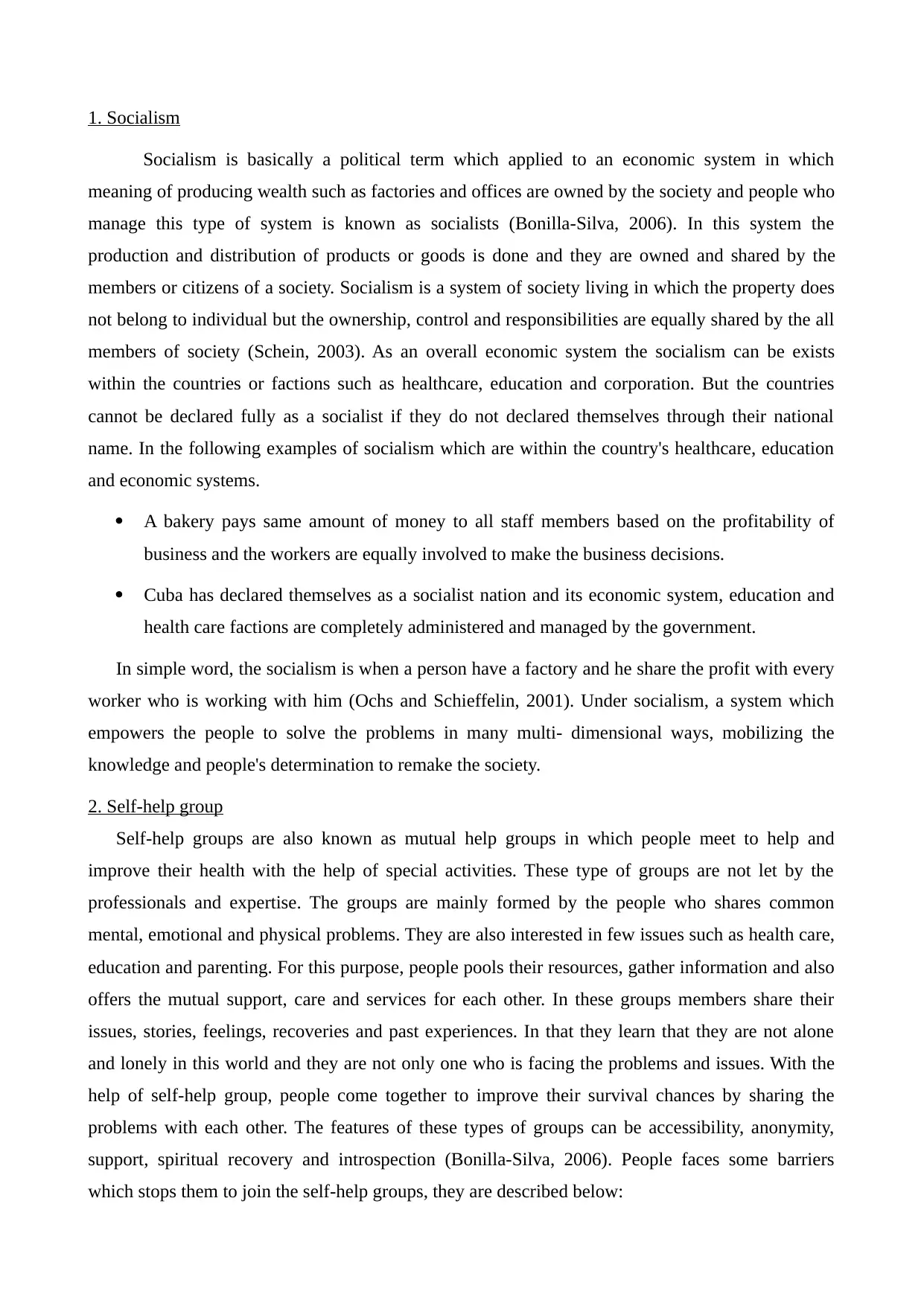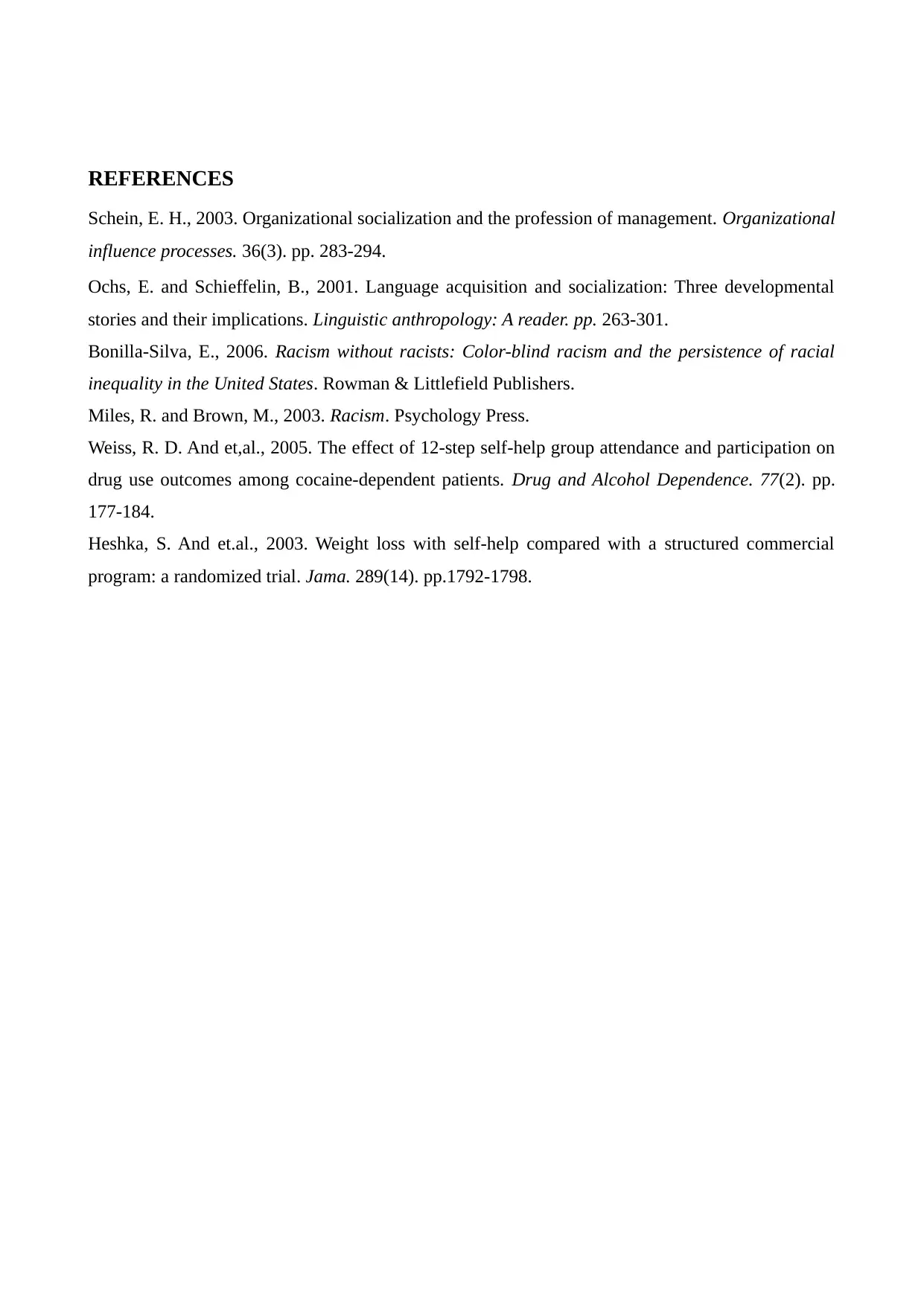Analysis of Health and Social Care Concepts: Socialism, Racism, Groups
VerifiedAdded on 2019/12/03
|5
|1150
|174
Homework Assignment
AI Summary
This assignment explores three key concepts within health and social care: socialism, self-help groups, and racism. The first section defines socialism as an economic system where the means of production are owned by society, providing examples in healthcare and education. The second part focuses on self-help groups, detailing their function in providing mutual support and addressing barriers to participation. The final section examines racism, its manifestations in the workplace, and a specific case study of racial discrimination in healthcare, highlighting its impact on individuals and the importance of institutional responses. The assignment provides definitions, examples, and analysis of each concept, supported by references.

Health and social care
Paraphrase This Document
Need a fresh take? Get an instant paraphrase of this document with our AI Paraphraser

1. Socialism
Socialism is basically a political term which applied to an economic system in which
meaning of producing wealth such as factories and offices are owned by the society and people who
manage this type of system is known as socialists (Bonilla-Silva, 2006). In this system the
production and distribution of products or goods is done and they are owned and shared by the
members or citizens of a society. Socialism is a system of society living in which the property does
not belong to individual but the ownership, control and responsibilities are equally shared by the all
members of society (Schein, 2003). As an overall economic system the socialism can be exists
within the countries or factions such as healthcare, education and corporation. But the countries
cannot be declared fully as a socialist if they do not declared themselves through their national
name. In the following examples of socialism which are within the country's healthcare, education
and economic systems.
A bakery pays same amount of money to all staff members based on the profitability of
business and the workers are equally involved to make the business decisions.
Cuba has declared themselves as a socialist nation and its economic system, education and
health care factions are completely administered and managed by the government.
In simple word, the socialism is when a person have a factory and he share the profit with every
worker who is working with him (Ochs and Schieffelin, 2001). Under socialism, a system which
empowers the people to solve the problems in many multi- dimensional ways, mobilizing the
knowledge and people's determination to remake the society.
2. Self-help group
Self-help groups are also known as mutual help groups in which people meet to help and
improve their health with the help of special activities. These type of groups are not let by the
professionals and expertise. The groups are mainly formed by the people who shares common
mental, emotional and physical problems. They are also interested in few issues such as health care,
education and parenting. For this purpose, people pools their resources, gather information and also
offers the mutual support, care and services for each other. In these groups members share their
issues, stories, feelings, recoveries and past experiences. In that they learn that they are not alone
and lonely in this world and they are not only one who is facing the problems and issues. With the
help of self-help group, people come together to improve their survival chances by sharing the
problems with each other. The features of these types of groups can be accessibility, anonymity,
support, spiritual recovery and introspection (Bonilla-Silva, 2006). People faces some barriers
which stops them to join the self-help groups, they are described below:
Socialism is basically a political term which applied to an economic system in which
meaning of producing wealth such as factories and offices are owned by the society and people who
manage this type of system is known as socialists (Bonilla-Silva, 2006). In this system the
production and distribution of products or goods is done and they are owned and shared by the
members or citizens of a society. Socialism is a system of society living in which the property does
not belong to individual but the ownership, control and responsibilities are equally shared by the all
members of society (Schein, 2003). As an overall economic system the socialism can be exists
within the countries or factions such as healthcare, education and corporation. But the countries
cannot be declared fully as a socialist if they do not declared themselves through their national
name. In the following examples of socialism which are within the country's healthcare, education
and economic systems.
A bakery pays same amount of money to all staff members based on the profitability of
business and the workers are equally involved to make the business decisions.
Cuba has declared themselves as a socialist nation and its economic system, education and
health care factions are completely administered and managed by the government.
In simple word, the socialism is when a person have a factory and he share the profit with every
worker who is working with him (Ochs and Schieffelin, 2001). Under socialism, a system which
empowers the people to solve the problems in many multi- dimensional ways, mobilizing the
knowledge and people's determination to remake the society.
2. Self-help group
Self-help groups are also known as mutual help groups in which people meet to help and
improve their health with the help of special activities. These type of groups are not let by the
professionals and expertise. The groups are mainly formed by the people who shares common
mental, emotional and physical problems. They are also interested in few issues such as health care,
education and parenting. For this purpose, people pools their resources, gather information and also
offers the mutual support, care and services for each other. In these groups members share their
issues, stories, feelings, recoveries and past experiences. In that they learn that they are not alone
and lonely in this world and they are not only one who is facing the problems and issues. With the
help of self-help group, people come together to improve their survival chances by sharing the
problems with each other. The features of these types of groups can be accessibility, anonymity,
support, spiritual recovery and introspection (Bonilla-Silva, 2006). People faces some barriers
which stops them to join the self-help groups, they are described below:

People do not have enough time to join these types of groups.
Feels fear to be disclose in the society.
Feels that their identity, personal information and personal problems will be disclosed to
everyone.
Lack of encouragement and support from the families and friends.
Lack of motivation to attend these types of groups.
Many people did not know how to approach these types of groups.
Most of the people do not know the process of these groups and many of them are not aware
about this (Miles and Brown, 2003).
Lack of confidence to attend these groups.
3. Racism
Racism consists the practices and activities which seek to justify or cause the violence and poor
treatment against the people because of social perception. The cause of racism is unequal behaviour
and distribution of privileges and rights among the various type of different racial groups. Basically
the variants are based on the social perception in biological difference between the people of racial
groups.
At the workplace it is very difficult to address the racism by management because it is
hideously done by few employees. The poor treatment and behaviour difference can cause the
racism at work place (Heshka, 2003).
Racism also contains the discriminatory behaviour and beliefs which can be based on the
religion, culture, caste, ethnic, national, society status and individual achievements. People
generally thinks that they are superior and they have all rights to dominate and disobey others who
are inferior to them (Weiss, 2005).
Example of racism:-
The black staff nurse, Rosie Purves had been abused by the white mother. In this case the mother
did not want a black nurse for looking after her child who was suffering from cystic fibrosis. While
the nurse was taking care of her child and the mother start shouting that Purves had no right to be a
nurse in the hospital because she is black. The hospital trust moved that child to another ward
instead of taking the actions against the racist behaviour of that white mother. Through this instance
Purves became depressed and was sick for 6 months. Then she decided to take a stand because she
felt that trust should have supported her. She was not against the mother but she was against the
hospital trust because trust did not take the racism seriously. For the stand the employment tribunal
Feels fear to be disclose in the society.
Feels that their identity, personal information and personal problems will be disclosed to
everyone.
Lack of encouragement and support from the families and friends.
Lack of motivation to attend these types of groups.
Many people did not know how to approach these types of groups.
Most of the people do not know the process of these groups and many of them are not aware
about this (Miles and Brown, 2003).
Lack of confidence to attend these groups.
3. Racism
Racism consists the practices and activities which seek to justify or cause the violence and poor
treatment against the people because of social perception. The cause of racism is unequal behaviour
and distribution of privileges and rights among the various type of different racial groups. Basically
the variants are based on the social perception in biological difference between the people of racial
groups.
At the workplace it is very difficult to address the racism by management because it is
hideously done by few employees. The poor treatment and behaviour difference can cause the
racism at work place (Heshka, 2003).
Racism also contains the discriminatory behaviour and beliefs which can be based on the
religion, culture, caste, ethnic, national, society status and individual achievements. People
generally thinks that they are superior and they have all rights to dominate and disobey others who
are inferior to them (Weiss, 2005).
Example of racism:-
The black staff nurse, Rosie Purves had been abused by the white mother. In this case the mother
did not want a black nurse for looking after her child who was suffering from cystic fibrosis. While
the nurse was taking care of her child and the mother start shouting that Purves had no right to be a
nurse in the hospital because she is black. The hospital trust moved that child to another ward
instead of taking the actions against the racist behaviour of that white mother. Through this instance
Purves became depressed and was sick for 6 months. Then she decided to take a stand because she
felt that trust should have supported her. She was not against the mother but she was against the
hospital trust because trust did not take the racism seriously. For the stand the employment tribunal
⊘ This is a preview!⊘
Do you want full access?
Subscribe today to unlock all pages.

Trusted by 1+ million students worldwide

awarded her £20,000.
Paraphrase This Document
Need a fresh take? Get an instant paraphrase of this document with our AI Paraphraser

REFERENCES
Schein, E. H., 2003. Organizational socialization and the profession of management. Organizational
influence processes. 36(3). pp. 283-294.
Ochs, E. and Schieffelin, B., 2001. Language acquisition and socialization: Three developmental
stories and their implications. Linguistic anthropology: A reader. pp. 263-301.
Bonilla-Silva, E., 2006. Racism without racists: Color-blind racism and the persistence of racial
inequality in the United States. Rowman & Littlefield Publishers.
Miles, R. and Brown, M., 2003. Racism. Psychology Press.
Weiss, R. D. And et,al., 2005. The effect of 12-step self-help group attendance and participation on
drug use outcomes among cocaine-dependent patients. Drug and Alcohol Dependence. 77(2). pp.
177-184.
Heshka, S. And et.al., 2003. Weight loss with self-help compared with a structured commercial
program: a randomized trial. Jama. 289(14). pp.1792-1798.
Schein, E. H., 2003. Organizational socialization and the profession of management. Organizational
influence processes. 36(3). pp. 283-294.
Ochs, E. and Schieffelin, B., 2001. Language acquisition and socialization: Three developmental
stories and their implications. Linguistic anthropology: A reader. pp. 263-301.
Bonilla-Silva, E., 2006. Racism without racists: Color-blind racism and the persistence of racial
inequality in the United States. Rowman & Littlefield Publishers.
Miles, R. and Brown, M., 2003. Racism. Psychology Press.
Weiss, R. D. And et,al., 2005. The effect of 12-step self-help group attendance and participation on
drug use outcomes among cocaine-dependent patients. Drug and Alcohol Dependence. 77(2). pp.
177-184.
Heshka, S. And et.al., 2003. Weight loss with self-help compared with a structured commercial
program: a randomized trial. Jama. 289(14). pp.1792-1798.
1 out of 5
Related Documents
Your All-in-One AI-Powered Toolkit for Academic Success.
+13062052269
info@desklib.com
Available 24*7 on WhatsApp / Email
![[object Object]](/_next/static/media/star-bottom.7253800d.svg)
Unlock your academic potential
Copyright © 2020–2025 A2Z Services. All Rights Reserved. Developed and managed by ZUCOL.





